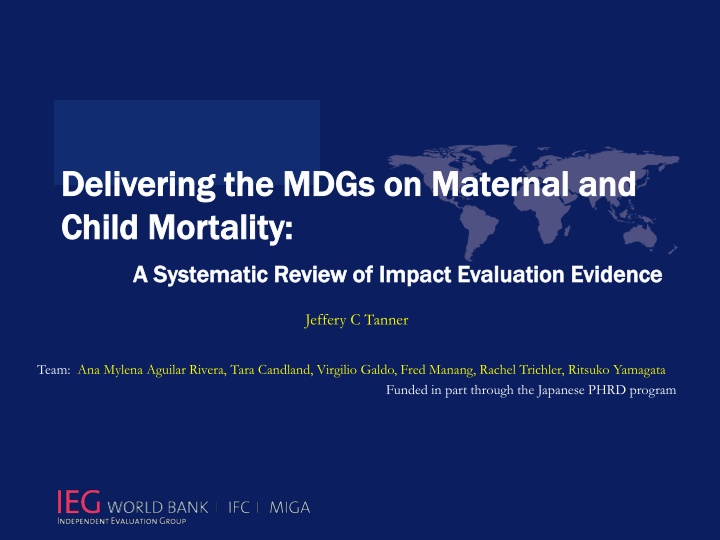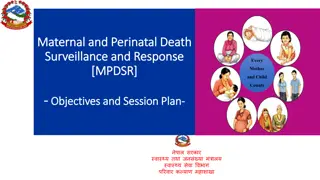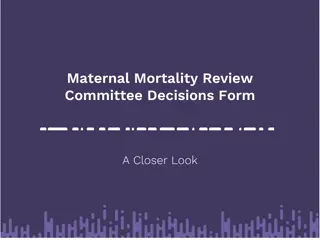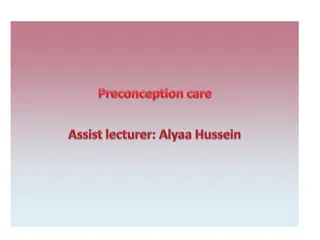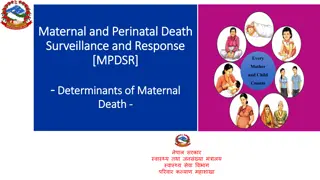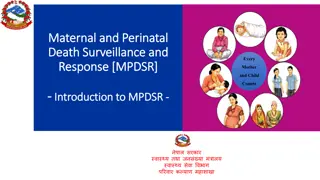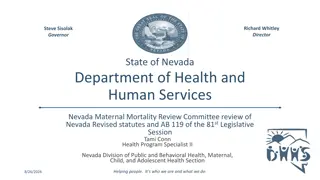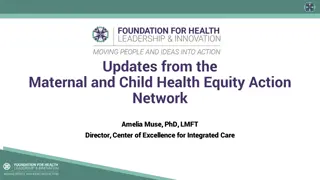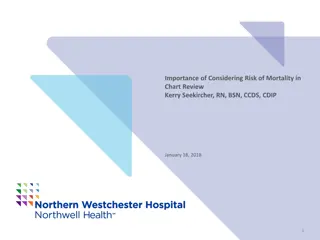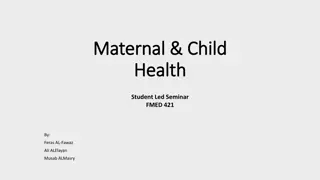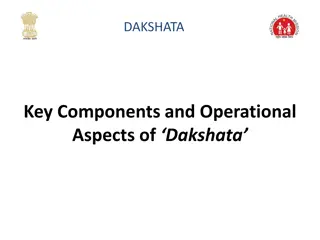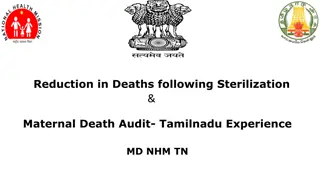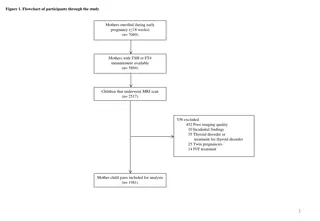Impact Evaluation of Interventions for Maternal and Child Mortality
This systematic review evaluates the impact of interventions on reducing maternal and child mortality rates, focusing on skilled birth attendance. It aims to identify effective strategies, gaps in knowledge, and outcomes related to maternal and child health outcomes. The conceptual model outlines inputs, outputs, and outcomes for reducing mortality rates through various intervention areas.
Download Presentation

Please find below an Image/Link to download the presentation.
The content on the website is provided AS IS for your information and personal use only. It may not be sold, licensed, or shared on other websites without obtaining consent from the author.If you encounter any issues during the download, it is possible that the publisher has removed the file from their server.
You are allowed to download the files provided on this website for personal or commercial use, subject to the condition that they are used lawfully. All files are the property of their respective owners.
The content on the website is provided AS IS for your information and personal use only. It may not be sold, licensed, or shared on other websites without obtaining consent from the author.
E N D
Presentation Transcript
Delivering the MDGs on Maternal and Delivering the MDGs on Maternal and Child Mortality: Child Mortality: A Systematic Review of Impact Evaluation Evidence A Systematic Review of Impact Evaluation Evidence Jeffery C Tanner Team: Ana Mylena Aguilar Rivera, Tara Candland, Virgilio Galdo, Fred Manang, Rachel Trichler, Ritsuko Yamagata Funded in part through the Japanese PHRD program
MDGs 4 and 5 Continue to Lag MDGs 4 and 5 Continue to Lag 100 94 96 96 100 100 87 87 87 80 80 78 72 80 68 52 51 60 38 40 20 0 $1.25 a day, 2005 per 100,000 live relevant age group) MDG 5.a Maternal MDG 3.1 Ratio of MDG 1.a Extreme rate, children under MDG 7.c Improved MDG 7.c Improved MDG 4.a Mortality MDG 4.a Mortality (modeled estimate, completion rate (% population without sanitation facilities population below MDG 2.1 Primary 1,000 live births) rate, infants (per secondary girls to boys in water source (% without access) (% popuplation mortality ratio primary and 5 (per 1,000) poverty (% access) Corresponding target Latest available value MDG5: Reduction in Maternal Mortality by 2015 Main Indicator: Proportion of births attended by skilled health personnel MDG4: 2/3 Reduction in Under-Five Mortality Knowing what to do is no longer the problem; knowing how to do it remains a challenge
Objective of this Systematic Review Objective of this Systematic Review Outcome-oriented approach Reviews impact evaluations of interventions to improve five MCM outcomes (SBA, MM, NM, IM, U5M) and those of SBA as an intervention Aims to answer the following questions: What interventions demonstrate reductions in maternal and child mortality and increase skilled birth attendance? What do we know about the effects of increasing skilled birth attendance? What important knowledge gaps remain on interventions to reduce maternal and child mortality?
Conceptual model: Conceptual model: Reducing Reducing maternal and child mortality maternal and child mortality INPUTS INPUTS Governance Governance Intervention areas: Strategic planning Resource generation Partnerships National guidelines Provision Provision Utilization Utilization Individuals, households, communities Intervention areas: Health sector Other sectors Intervention areas: Service delivery Health financing Health workforce Health information Medical products & tech Water and sanitation Transport Education Energy Agriculture / Nutrition Seek to affect: Knowledge and information Ability to pay Household Environment and Infrastructure Transportation Seek to affect: - Availability - Equity - Quality of services - Affordability - Efficiency - Behavioral change - Cultural norms - Practices OUTPUTS OUTPUTS Improved access to essential maternal and child care Improved healthy practices and lifestyles Improved care seeking behavior and utilization Improved access to basic non-health services and nutritious food OUTCOME OUTCOME Reduced maternal and childhood mortality
Search Criteria Search Criteria Impact Evaluations Experimental or Quasi-Experimental design Counterfactual Completed 1995 Present Effectiveness / Policy / Field studies (Rather than bio-medical and efficacy trials) Low and Middle-Income Countries Representative Sample of population of interest Peer Review Report impacts on at least 1 outcome of interest Skilled Birth Attendance, Maternal Mortality Neonatal, Infant, Under-five Mortality
Search Process Search Process 3 Search Rounds Electronic, hand and snowball search strategies Review and coding into 300+ fields 7,000 62 studies Quality Ratings by Internal Validity Elements of Construct and External Validity also considered
Frequency of Impact Evaluations Frequency of Impact Evaluations by Outcome and Quality by Outcome and Quality 69 Impact Evaluations AAA rating AA rating Total Skilled birth attendant 10 23 33 Neonatal mortality 9 17 26 Infant mortality 11 12 23 Under-5 mortality 5 12 17 Maternal mortality 3 5 8 AAA-quality Impact Evaluations: Established Causality Few, if any, remaining threats to internal validity. AA-quality Impact Evaluations: Likely Causality Some identifying assumptions untested or unclear Consistency Analysis. Key Results driven by AAA-rated IES Contextual Information considered as present in IEs This is a baseline of sorts. Thin evidence means findings are preliminary but still instructive
Sample: Standardized Effect Size Sample: Standardized Effect Size-- -- Infant Mortality Infant Mortality
Findings on Interventions for Mothers Findings on Interventions for Mothers No Robust Evidence that solely increasing proportion of births with SBA affects mortality Only evaluated program is JSY in India: Gives a null results 2 IEs, High and Medium quality, both high-powered No effect even in areas with high (or low) quality of health services Critical Knowledge gap: Need more IEs on this MDG indicator Complimentary and reinforcing strategies that simultaneously improve both Provision and Utilization (supply and demand), esp. quality of care, knowledge, and access to services, can improve SBA and reduce MM Conditional Cash Transfers, Vouchers promising But cannot disentangle the combined effect of utilization and quality May lead to unintended consequences (increased fertility)
Findings on Interventions for Children Findings on Interventions for Children Community-based interventions which components and improve home-based care may reduce neonatal mortality Non-health sector interventions (Education, Water, Energy) can reduce child mortality (NM, IM, U5) IMCI and Safe Motherhood not significant Though thin, the evidence is consistent that Governance interventions can reduce child mortality Evidence from health sector is often significant for AAA-rated IEs, not for AA-rated IEs
External Validity Implications: Beneficial External Validity Implications: Beneficial Impacts are more likely in problematic areas Impacts are more likely in problematic areas Neonatal Mortality Skilled Birth Attendance Infant Mortality Under-Five Mortality
Gaps by Region Gaps by Region 1 IE 1 MM 1 IM 0 IEs 15 IEs 10 SBA 2 MM 4 NM 7 IM 3 U5 28 IEs 15 SBA 5 MM 18 NM 6 IM 4 U5 15 IEs 3 SBA 1 NM 9 IM 7 U5 9 IEs 5 SBA 3 NM 3 U5
Gaps by Severity Gaps by Severity Skilled birthattendant Maternal mortality Neonatalmortality Infant mortality Under 5 mortality [500] [34] [69] [108] 40 100 [32] Severity Index (100=worse indicator value) [49] [49] 90 35 80 [49] Impact Evaluations 30 70 [84] [63] 25 60 [98][94][93] 20 50 [220] [14] [24] 40 [11][10] 15 [29] [17][16] 30 [8] [14] 10 [17][20] [20] [83] [81] [80] 20 5 [32] 10 0 0 ECA EAP LAC MENA SA SSA ECA EAP LAC MENA SA SSA ECA EAP LAC MENA SA SSA ECA EAP LAC MENA SA SSA ECA EAP LAC MENA SA SSA Impact Evaluations Severity
Other Gaps in Impact Evaluation Evidence Other Gaps in Impact Evaluation Evidence By Intervention Type Governance Health information systems, Health Infrastructure Health financing Income generating / Labor market interventions Agriculture / food security / nutrition Transportation infrastructure Evaluation Components Distributional impacts (heterogeneous effects) Where reported (30%), effects are larger for disadvantaged groups Cost analysis
In Summary In Summary In spite of slow progress globally on MDGs 4 and 5, We find evidence of effective interventions to reduce maternal and child mortality. Governance SBA+ Non-Health Sectors Lower SES households and Countries with higher burdens may see larger results from these interventions. There is no evidence that increasing skilled birth attendance alone reduces maternal or neonatal mortality. Important knowledge gaps remain Region Intervention Type (including SBA) Evaluation components
Backup Slides Backup Slides
Challenges and Cautions Challenges and Cautions for Systematic Reviews for Systematic Reviews Representativeness of Interventions non-random selection Overrepresentation of easily evaluable interventions Focus on reduced form studies excludes those with intermediate outcomes Lack of evidence does not imply no effect Representativeness of Impact Evaluations Includes only existing studies Publication bias (file drawer bias) Interpretation of Results IEs measure partial equilibrium; general equilibrium may be different Null results must be interpreted carefully we never accept zero External validity changes to time, place, or scale may affect results
Standardized Effect Size: Standardized Effect Size: SBA SBA-- --Outcome Outcome
Standardized Effect Size: Standardized Effect Size: Maternal Mortality Maternal Mortality
Standardized Effect Size: Standardized Effect Size: Neonatal Mortality Neonatal Mortality
Standardized Effect Size: Standardized Effect Size: Infant Mortality Infant Mortality
Standardized Effect Size: Standardized Effect Size: Under Under- -Five Mortality Five Mortality
Skilled Birth Attendance Skilled Birth Attendance Outcome Outcome Conditional Cash Transfers and Vouchers can improve SBA Interventions that bundle quality improvements with increased accessibility found can improve SBA Solely training health workforce or increasing awareness of safe motherhood was not observed to yield significant results Where reported, effects are larger for more disadvantaged households
Skilled Birth Attendance Skilled Birth Attendance -- -- Intervention Intervention No Robust Evidence that solely increasing proportion of births with SBA affects mortality Only evaluated program is JSY in India: Null results for NM 2 IEs, AAA and AA quality, both high-powered No effect even in areas with high (or low) quality of health services Critical Knowledge gap: Need more IEs on this MDG indicator SBA + Can affect mortality and intermediate outcomes PLUS=Provision & Utilization: quality of care, knowledge, access But evidence is mixed across outcomes, even within a given study Unclear what explains variation in results Consistent, if thin, evidence on better U5M, Breastfeeding, Family planning, Postnatal visits, Immunization, Anthropometric outcomes
Maternal Mortality Maternal Mortality Few (8) studies exist, concentrated in SA (5) Most studies underpowered to detect effects in MM Interventions bundling components of both health care provision and utilization can reduce maternal mortality. Specifically, bundling health worker training and mothers knowledge and information (with and without insurance) More evaluations are needed Family planning, universal health, referral systems, transport SSA, MENA, and LAC
Neonatal Mortality Neonatal Mortality Interventions in non-health sectors associated with maternal education consistently lowered neonatal mortality Knowledge & Information interventions in the sample which change home-based care practices at the community level reduced mortality More IEs are needed in Referral Systems and Transportation Improvements in Quality and Availability of Health Infrastructure for newborns Africa and LAC
Infant Mortality Infant Mortality Interventions in non-health sectors consistently reduced IM Water and Sanitation Energy Education Governance interventions report significant effects in lowering infant mortality Training health workers to provide continuum of care services within communities can reduce IM Attention to IE quality and intervention details is important More AAA-quality IEs needed from other health sector interventions, SSA Where reported, households from lower SES benefited more
Under Under- -Five Mortality Five Mortality Interventions in non-health sectors consistently report large reductions in under-five mortality. Public Participation, Service Packages may reduce U5M Insecticide Treated Nets are only intervention targeting three main causes of mortality that has IE evidence on U5M No AAA IEs of Governance programs; but AA IEs of strategy planning & policy and monitoring & evaluation consistently reveal reduction in U5 mortality
